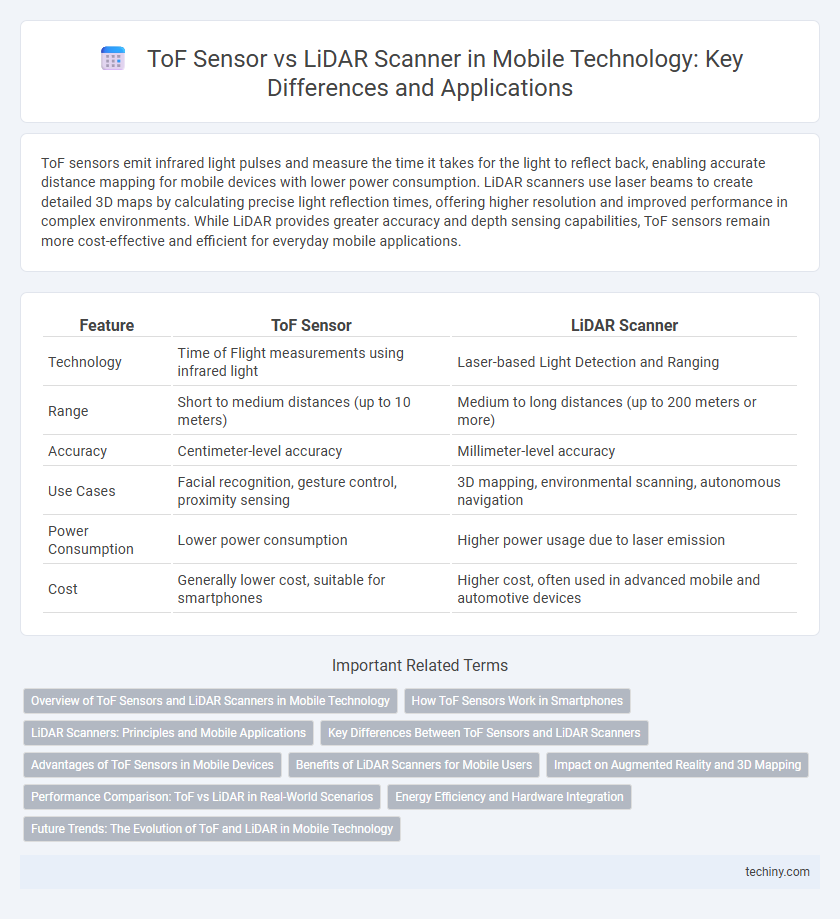ToF sensors emit infrared light pulses and measure the time it takes for the light to reflect back, enabling accurate distance mapping for mobile devices with lower power consumption. LiDAR scanners use laser beams to create detailed 3D maps by calculating precise light reflection times, offering higher resolution and improved performance in complex environments. While LiDAR provides greater accuracy and depth sensing capabilities, ToF sensors remain more cost-effective and efficient for everyday mobile applications.
Table of Comparison
| Feature | ToF Sensor | LiDAR Scanner |
|---|---|---|
| Technology | Time of Flight measurements using infrared light | Laser-based Light Detection and Ranging |
| Range | Short to medium distances (up to 10 meters) | Medium to long distances (up to 200 meters or more) |
| Accuracy | Centimeter-level accuracy | Millimeter-level accuracy |
| Use Cases | Facial recognition, gesture control, proximity sensing | 3D mapping, environmental scanning, autonomous navigation |
| Power Consumption | Lower power consumption | Higher power usage due to laser emission |
| Cost | Generally lower cost, suitable for smartphones | Higher cost, often used in advanced mobile and automotive devices |
Overview of ToF Sensors and LiDAR Scanners in Mobile Technology
Time-of-Flight (ToF) sensors and LiDAR scanners both rely on emitting light pulses to measure distance, but ToF sensors use near-infrared light for rapid depth mapping, ideal for mobile devices due to their compact size and lower power consumption. LiDAR scanners employ laser beams and precise timing to generate high-resolution 3D maps, offering superior accuracy and range, primarily utilized in advanced augmented reality and automotive applications. In mobile technology, ToF sensors provide cost-effective and efficient depth sensing for facial recognition and camera enhancements, while LiDAR scanners deliver enhanced spatial awareness for immersive AR experiences.
How ToF Sensors Work in Smartphones
ToF sensors in smartphones measure the time it takes for emitted infrared light to reflect off objects and return to the sensor, enabling precise distance calculations and depth mapping. This technology allows rapid 3D scanning, improved autofocus in low light, and enhanced augmented reality experiences. Compared to LiDAR scanners, ToF sensors are typically more compact and cost-effective, making them ideal for mobile devices.
LiDAR Scanners: Principles and Mobile Applications
LiDAR scanners utilize laser pulses to measure distances by calculating the time it takes for light to reflect back from objects, enabling precise 3D mapping and spatial awareness in mobile devices. These sensors deliver higher accuracy and longer range compared to Time-of-Flight (ToF) sensors, making them ideal for augmented reality (AR), advanced photography, and autonomous navigation applications. Mobile devices equipped with LiDAR scanners provide enhanced depth perception and real-time environmental mapping, significantly improving user experience in gaming, virtual object placement, and accessibility features.
Key Differences Between ToF Sensors and LiDAR Scanners
ToF sensors measure distance by calculating the time taken for emitted light pulses to reflect off objects and return, offering quick depth sensing with typically shorter range and lower resolution. LiDAR scanners utilize laser beams to create precise 3D maps by scanning environments in high detail, enabling longer ranges and higher accuracy for applications such as autonomous driving and mapping. The key differences revolve around range, resolution, and application scope, with ToF favoring compact, short-range use and LiDAR excelling in detailed spatial data collection over greater distances.
Advantages of ToF Sensors in Mobile Devices
ToF sensors offer faster depth-sensing capabilities with lower power consumption compared to LiDAR scanners, making them ideal for mobile devices. Their compact size allows integration into slim smartphone designs without compromising performance. Enhanced accuracy in close-range measurements improves facial recognition and augmented reality applications, providing a seamless user experience.
Benefits of LiDAR Scanners for Mobile Users
LiDAR scanners offer mobile users enhanced depth accuracy and faster 3D mapping compared to ToF sensors, enabling more precise augmented reality experiences and improved environmental sensing. Their ability to capture detailed spatial information in various lighting conditions benefits navigation, gaming, and photography applications on smartphones. LiDAR's high-resolution data streamlines object recognition and distance measurement, providing mobile devices with superior situational awareness and interaction capabilities.
Impact on Augmented Reality and 3D Mapping
ToF sensors provide fast depth information with lower power consumption, enhancing real-time augmented reality experiences by enabling smoother object interactions and spatial awareness. LiDAR scanners offer higher precision and longer-range 3D mapping capabilities, critical for detailed environmental modeling and accurate virtual object placement in AR applications. Combining ToF and LiDAR technologies improves depth sensing accuracy and reliability, advancing AR immersion and robust 3D spatial understanding.
Performance Comparison: ToF vs LiDAR in Real-World Scenarios
ToF sensors excel in short-range depth sensing with lower power consumption, making them ideal for indoor applications like facial recognition and gesture control. LiDAR scanners provide superior accuracy and longer range, capturing detailed 3D maps essential for autonomous vehicles and outdoor navigation. In real-world scenarios, LiDAR's high-resolution point clouds outperform ToF sensors in complex environments with variable lighting and larger distances.
Energy Efficiency and Hardware Integration
ToF sensors generally consume less power than LiDAR scanners, making them more energy-efficient for mobile devices where battery life is critical. LiDAR scanners require more complex hardware and larger components, posing integration challenges in compact smartphone designs. ToF technology's smaller form factor allows easier incorporation into slim devices without significantly impacting energy consumption.
Future Trends: The Evolution of ToF and LiDAR in Mobile Technology
Future trends in mobile technology indicate rapid advancements in both ToF sensors and LiDAR scanners, with ToF evolving through improved accuracy and miniaturization for enhanced depth sensing in smartphones. LiDAR technology is expected to gain broader adoption due to its superior range and precision, enabling more sophisticated augmented reality experiences and autonomous navigation. Integration of AI-driven processing will further optimize both sensors, transforming mobile devices into powerful tools for 3D mapping and immersive applications.
ToF sensor vs LiDAR scanner Infographic

 techiny.com
techiny.com